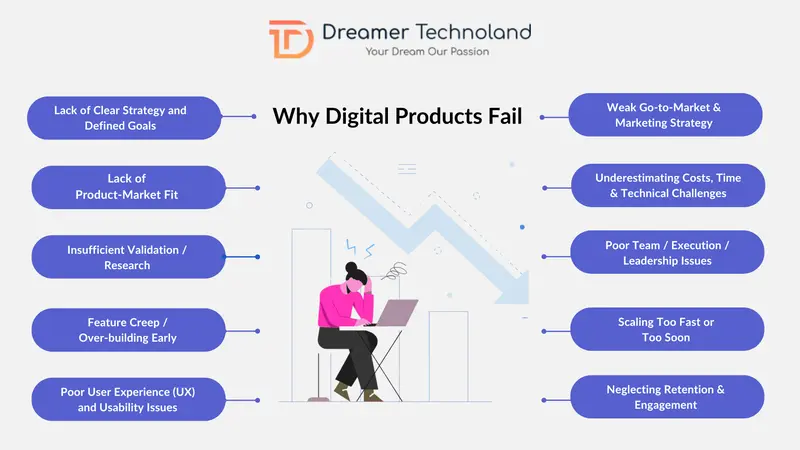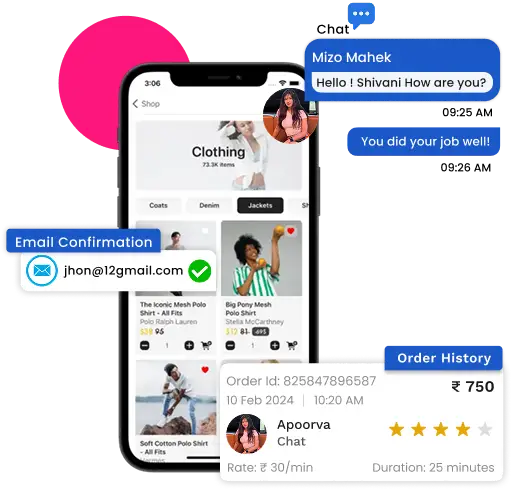Businesses across industries are investing heavily in building digital products — from mobile apps and enterprise software to online platforms and digital services. The motivation is clear: meet evolving customer expectations, stay competitive, and unlock new revenue streams. Yet, despite the immense potential, the journey from concept to successful launch is filled with challenges. According to MIT Professional Programs referencing late Clayton Christensen’s findings on innovation and disruption, nearly 95% of the 30,000 new products launched each year fail — a sobering reminder of how challenging digital product success truly is.
Many of these failures stem from pitfalls in digital product design and launch phases — mistakes like insufficient market research, unclear vision, or poor execution. These errors can cost organizations significant time, money, and effort.
So, how do you give your digital product a strong chance of success in a highly competitive market? In this blog, we’ll cover why many digital products fail, typical pitfalls in design and launch, and proven solutions to overcome them—drawing on Dreamer Technoland’s expertise in custom software and web/mobile application development.
Why Many Digital Products Fail
The failure rate of digital products usually arises from a combination of strategic missteps, design flaws, and execution problems. Too often, teams rush into development without clearly understanding their vision or what their target users truly need. Below are key reasons many digital products don’t make it:

Lack of Clear Strategy and Defined Goals
Without a clear strategy and well-defined goals, development teams can lose direction. This often results in wasted effort, feature bloat, and misalignment between what the product does and what the business intends.
Lack of Product‑Market Fit
Even the most beautifully built product won’t succeed if there’s no real demand. Many startups fail because they attempt to solve a problem that isn’t deeply felt by enough potential users.
Insufficient Validation / Research
Skipping user interviews, testing early assumptions, or doing minimal market research is risky. Without validation, you may end up building something no one wants.
Feature Creep / Over‑building Early
Trying to build all possible features at once slows down release, increases complexity, and often results in confusing user experience. It’s more effective to start with a lean Minimum Viable Product (MVP) that solves core pain points, then expand gradually.
Poor User Experience (UX) and Usability Issues
Even if the idea is compelling and the features are numerous, if the UX is badly designed, confusing, or buggy, users will abandon ship. Smooth usability, performance, and intuitive design are essential.
Weak Go‑to‑Market & Marketing Strategy
Building a great product is only half the battle. If no one knows about it, or if it’s badly positioned, messaging is unclear, pricing is wrong, or channels are off, the product won’t gain the traction it deserves.
Underestimating Costs, Time & Technical Challenges
Many projects underestimate the resources needed. Issues such as technical debt, scalability, infrastructure, security, and ongoing support can become huge drains on both product development cost and timeline.
Poor Team / Execution / Leadership Issues
Even with a great idea and market potential, a weak team, poor communication, lack of accountability, or inability to pivot when needed can all contribute to failure.
Scaling Too Fast or Too Soon
Trying to grow operations before metrics are stable (such as retention, user satisfaction, unit economics) can lead to overloaded systems, frustrated users, and financial strain.
Neglecting Retention & Engagement
Acquiring users is good — retaining them is what truly signals product‑market fit. If users don’t come back, engagement drops, or churn is high, even a strong launch can be undone.
Ignoring Market Trends, Competition & Changing Needs
Markets evolve. Customer preferences shift. New technologies emerge. A product that once had demand can become outdated or outpaced if it doesn’t adapt or respond to what competitors are doing.
What To Do to Avoid Failure
Based on our experience at Dreamer Technoland — which has been building web, mobile, desktop and custom software solutions, data visualization platforms, API integrations, and more since 2015 in Noida, India. Following strategies can significantly improve your chances of success:
Validate Early and Often
Build simple prototypes or MVPs. Talk to real users. Collect feedback before scaling.
Focus on the Real Problem
Make sure what you build addresses a genuine, felt need.
Prioritize Features
Start with core features. Avoid scope creep.
Invest in UX and Quality
Usability, performance, responsiveness, reliability: don’t skimp.
Use Data & Metrics
Track engagement, retention, churn, conversion. Make decisions based on data.
Be Ready to Pivot
If metrics aren’t working, or feedback points to changes needed, don’t be afraid to adjust your strategy.
Solutions: How Dreamer Technoland Implements Them
While general strategies are valuable, successful execution depends on applying them systematically. At Dreamer Technoland, we integrate these principles throughout every phase — from product discovery and design to development, testing, and scaling. Here’s how we at Dreamer Technoland embed these best practices in our process:
Clear Product Vision & SMART Goals
From the start, aligning product vision with our clients’ business goals; defining success metrics like activation rate, retention, revenue, etc.
Lean / Agile Development
Iterative releases, continuous feedback loops, and adapting quickly to change.
User Research & Validation
Deep user interviews, usability testing, observing behaviour, market and competitor analysis.
UX / Onboarding First
Designing intuitive flows, offering meaningful onboarding experiences, delivering quick wins to users early.
Continuous Monitoring
Dashboards and tracking systems to monitor retention, engagement, performance; A/B testing where relevant.
Scalable & Maintainable Architecture
Modular architecture, choosing appropriate technologies, planning for scale in frontend, backend, and infrastructure.
Cross‑Functional Teams & Clear Roles
Product, design, development, QA, marketing — everyone aligned, responsibilities clearly defined.
Marketing & Positioning from Day One
Defining USP, testing messaging, preparing launch channels, pre‑launch awareness, and ensuring pricing/distribution strategy is well thought‑through.
Adaptability & Continuous Improvement
Regular iteration based on feedback, market shifts, user suggestions, and evolving competition.
Key Takeaways
To wrap up, here are some of the most critical lessons that businesses should keep in mind while designing and launching digital products. These principles summarize what truly drives success and sustainability in the long run.
Start with Real User Needs
Products that solve genuine pain points are far more likely to succeed. Use research to uncover what users actually want.
Clarity of Vision, Goals & Metrics
Be clear about why the product exists, who it’s for, what value it delivers, and how success will be measured.
Iterate Early & Often
Don’t wait for perfection. Launch early versions, get feedback, improve. Agile or lean methodologies are very helpful.
Maintain Simplicity & Usability
Keep the design clean, intuitive. Avoid over‑complexity. Let users adopt the product easily.
Collect Feedback & Use Data
Combine qualitative user interviews and quantitative metrics to understand usage and course‑correct when needed.
Effective Onboarding & Quick Wins
Help users realize value early. Strong onboarding reduces drop‑off and improves engagement.
Scalability & Technical Robustness
Plan for growth from the start — both technological and operational scaling.
Cross‑Functional Collaboration & Clear Ownership
Make sure everyone knows who owns what. Strong leadership and communication matter.
Solid Launch & Go‑to‑Market Strategy
Even an excellent product may fail without strong positioning, messaging, pricing, and visibility.
Adaptability & Continuous Improvement
Be prepared to pivot. Revisit assumptions, tools, roadmap. Stay responsive to market changes.
Final Thoughts
Launching a successful digital product is hard — but avoidable mistakes can be managed with discipline, user‑centred thinking, and strong execution. At Dreamer Technoland, we offer end‑to‑end digital product development services: from strategy and design through development and launch, helping clients turn their visions into thriving digital experiences. If you’re ready to begin a project, sharpen your product approach, or need feedback on your plan, we’re here to support you.







